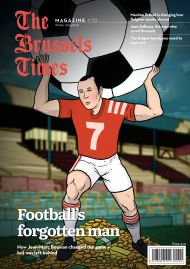Tram 25 starts its northbound journey to Rogier at, or just off, the railway bridge over Boondael Station. The station suits railway commuters coming in from the south of the country who wish to join the Brussels transport network. As a regular on both railway and tram I can attest that the station is both gorgeous and a lost opportunity. Situated in a cutting beneath the bridge it is a haven of jangly tree–growth and tweeting bird life. (The train traffic is not that intense) All this is spoiled somewhat by brutalist, concrete shelters and unfriendly stairways. The station is scheduled for a revamp. Let us hope for better things.
The Boondael stop is but a short walk from the Bois de la Cambre/Kamerenbos. This is a finger of parkland of about a square kilometre which points its way into Brussels proper – well, to the top of Louise – from the extensive Sonian Forest (Forêt de Soignes/Zoniënwoud). This forest once stretched to the Ardennes and thence to Poland. If you haven’t lain on the grass sloping down to the lake of a summers’ evening, idly watching the skateboarders, courting couples, daisy-chain makers, pack-forming dogs, blissful toddlers, beer-imbibers at the nearby buvette, hyperactive aquatic birds, an ice-cream van queue, and earnest, iPhone be-strapped runners then you have missed an authentic Brussels experience.
The 25 neatly links up two of Brussels’ major universities. Typically split on linguistic lines, but more amicably than some institutions, the eponymous educational establishments are a few tram stops apart. At stop ULB (Université Libre de Bruxelles) you can head west through the campus to inspect two or three fine university buildings. I have always had an affection for the main administrative building on Avenue Franklin Roosevelt: the architecture could best be described as neo-Flemish/Gothic/Oxbridge-aspirant. Passing by at night, its lights all blaze, it is a fine sight. The clock tower is gorgeous.
The French-speaking University as it is now constituted is the result of, not one but two, major fault lines in Belgian political and social life. First was the Catholic Liberal axis. Liberal, it should be explained, means almost the opposite of the American English usage, and refers to fierce defenders of liberty above all else.
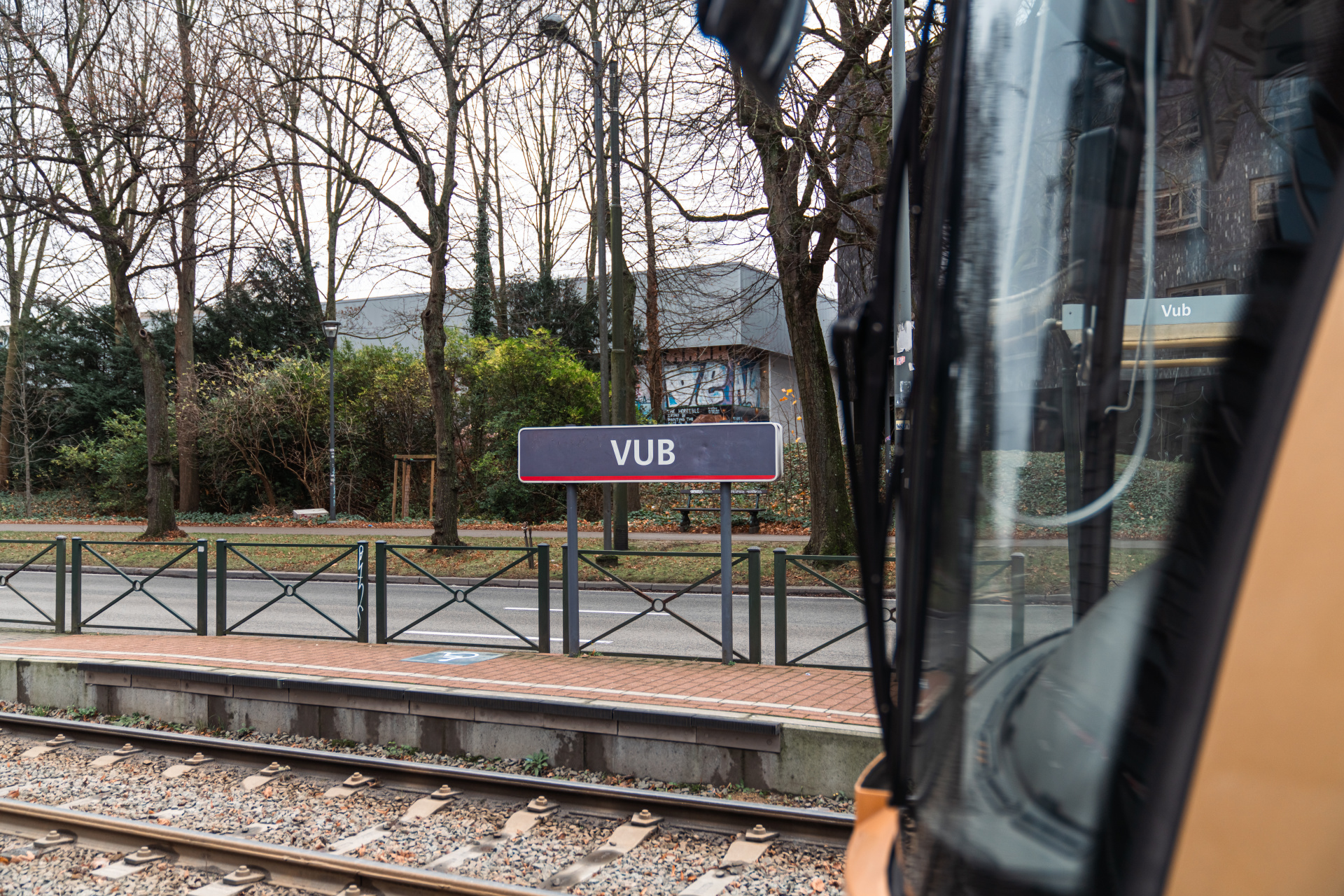
VUB tram stop
To oversimplify, when the new kingdom of Belgium was created, the Catholic church alarmed the liberals by founding, and funding, a new university in Mechelen. The liberals, rightly or wrongly, saw this as an assault upon the, well, liberal and French-inspired anti-clerical values of the new state. So this drove one Pierre-Théodore Verhaegen to take matters into his own hands and to found a sternly ‘liberal’ university in the then university-free Brussels. It thrived without help from the state. Only when approaching the main building did I notice his statue – and very handsome he looks in his frock coat, I must say!
It would be tedious to recount the history of this august establishment beyond recording that the ULN football team won a bronze medal in the 1900 Paris Olympics (although, Wikipedia coyly notes, not all the players were students). But then in the late 1960s things get interesting. Campuses are aflame around the world and Leuven, Belgium’s oldest and most prestigious university, splits rancorously along linguistic lines and Louvain-la-Neuve is founded.
Weird and Mad
ULB managed things rather better. It had been running courses in both languages throughout the 20th century. A new university was set up three of the 25’s tram stops away with the same name in Dutch – Universiteit Vrij van Brussel (VUB). It is housed in the old gunnery range, the tram stop is called VUB, the campus is agreeably hugger-mugger and easy to get lost in, relations with ULB are good (many lecture at both establishments), they both share a secular dedication to free inquiry and have created between them, literally, the small but buzzy, boozy, bar-y area around the Ixelles cemetery, and VUB is noted for its post 1960s democratic principles and whacky societies. One is called Society for Weird and Mad People (or SWAMP) and is dedicated to offbeat games. Neither establishment uses their English name – Free University of Brussels – as that would be ambiguous.
In between the two uni-stops is Buyl. It is where the eponymous west-bound Avenue Adolphe Buyl crosses the General Jacques Boulevard. It is of some complexity as two tram lines meet there and a major tram depot is 100 metres further down the hill. To add to this convolution, the tram stop has four different locations along the two arteries, all some distance from the crossing itself. I have thought of standing there and trying to work out the light sequences. But that would turn me into an umarell; and that I will not countenance.
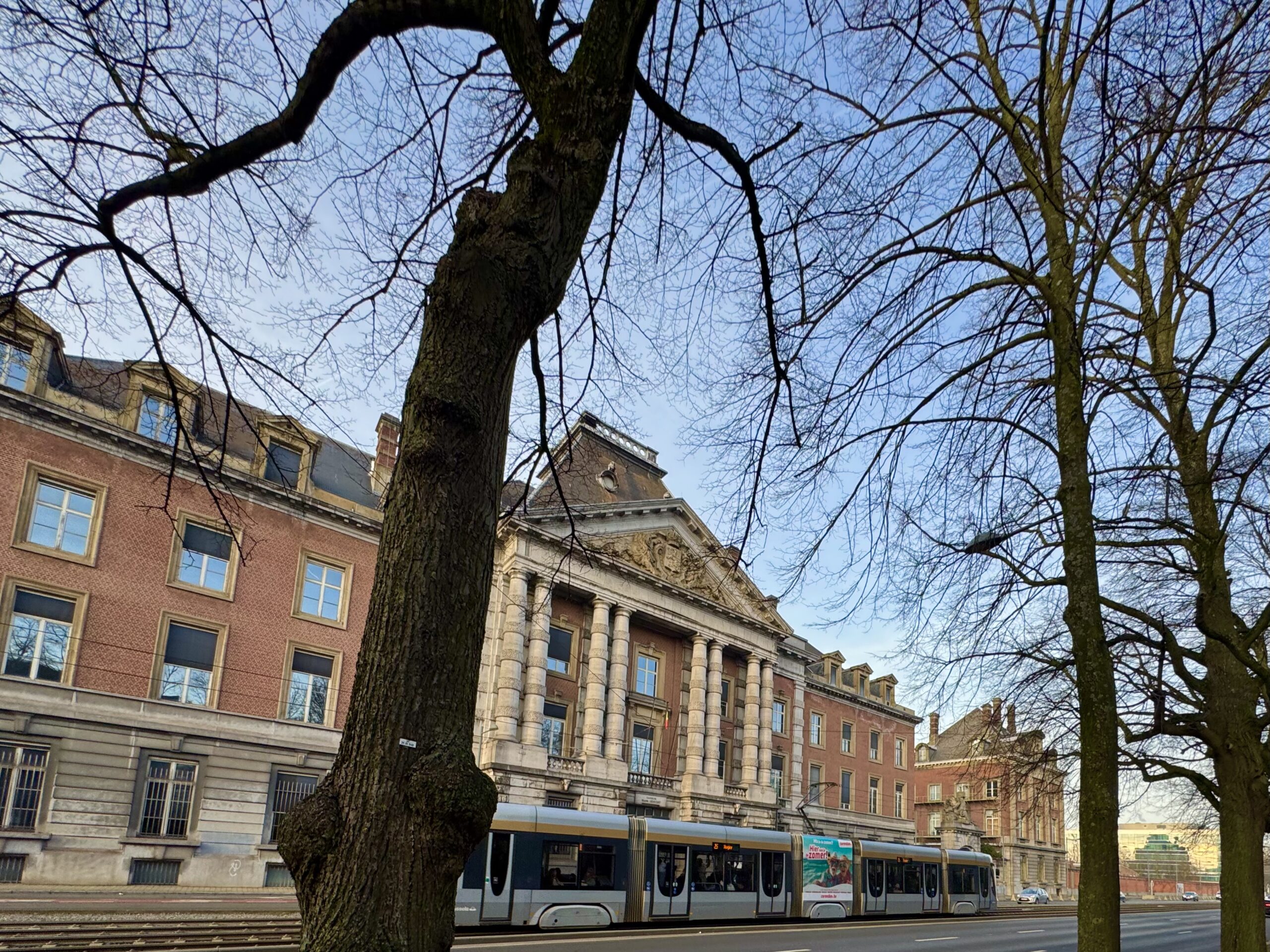
Barracks on the Boulevard General Jacques
The four corners of the crossroads are occupied severally by a small supermarket, a large pharmacy, a café and, last but not least, on the north-west corner, my favourite chipper. It is large as frituurs go, clean, Turkish-run, and the clientele a mixture of students (of course), workies in hi-viz trousers (the orange ones more dapper than the yellow for some reason) and a sprinkling of young mums with babies in buggies. All of this just to situate and contextualise my best cheap lunch in this part of town. I am treated like a lord and I have yet to finish a small portion of their delicious chips, slathered in ketchup, before my satiety bids me stop. With a can of something sugary I’m pushed to top €5! Incidentally my best high-price lunch is 400 metres further down the road, facing the Ixelles ponds, name of The Canterbury.
Jesuits and astrophysics
From the VUB the tram leaves the campus, plunges underground and stops at the vast (by Brussels’ standards) interchange named after Field Marshal Montgomery whose statue above, sporting a beret the size of a golf umbrella, looks masterfully down Avenue de Tervuren. As well he might, because that was the way his troops marched into Brussels to liberate it from the Nazis. The delirious citizens were further surprised to find a company of their compatriots among the saviours. Nice touch, Monty!
I feel a slight party-pooper if I record that the great man was not actually there. His troops had pretty much run the 120km from Douai in little over a day. He followed in a jeep a couple of days later to be received by the mayor as an all-conquering hero. Which, of course, is exactly what he was.
This brings me to Micheline who was then, I reckon, about eight years old. She was standing in front of the cheering crowd somewhere when a tank went rumbling past. A Tommy (her word) swept her up and perched her on top of the turret. She spent the entire glorious day riding around, waving at the crowd, feasting on the Tommy chocolate bars, recognising envious chums, bursting with pride and happiness, and obliviously driving her parents demented with worry. She is now a venerable dowager but when she told us the story in my English class she was that little girl again.
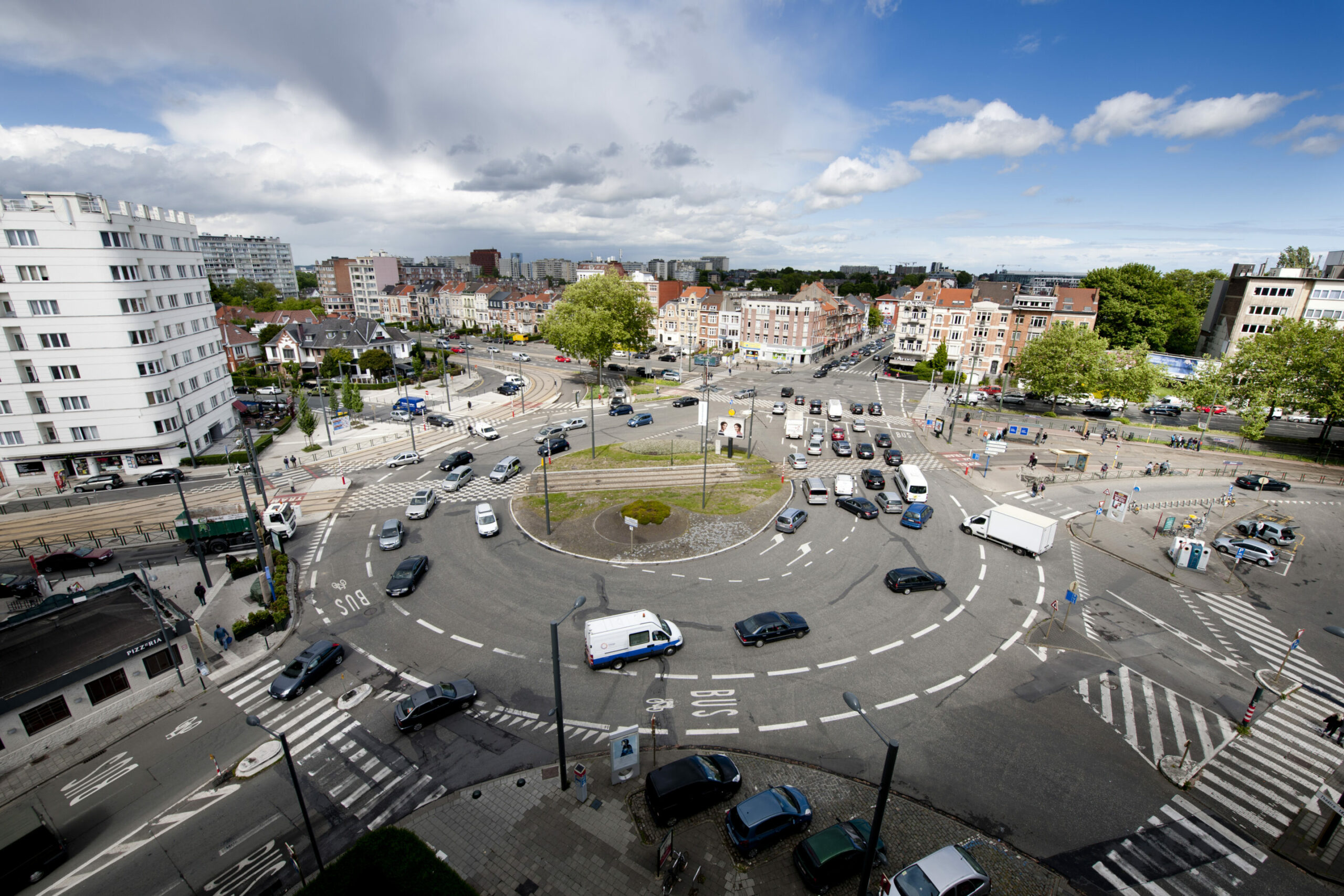
Illustrations picture shows Place Meier. Credit: Belga
If you stand to the south of the Montgomery roundabout, by that quirky, three-metre high, inaccessible tennis umpire’s seat (no, really) and look south you’ll spot the imposing Victorian-gothic/Romanesque Saint Michel College. This is a Jesuit boarding school, and the home of the Society of Bollandists, which collects religious books on saints.
It is also worth recording that astrophysicist Georges Lemaître studied here. And he put his education to good use when, as a Catholic priest and theoretical physicist, he was the first to fully comprehend and explain the Big Bang in 1926. He thus changed the way we understand the universe. Then, as now, scientific papers had to be published in English to be widely read. So it sunk without a trace. Such was his (very Belgian) modesty and low profile that only recently have there been moves to rename the so-called Hubble constant – the rate of expansion of the universe – the Hubble-Lemaitre constant (‘constant’ is somewhat of a misnomer as it is subject to continuing recalculations: I am tempted to rename it the Lemaitre-Hubble Variable!).
A shout out for the metro here. It can whisk you into the middle of town in no time flat from Montgomery. Now that the municipal aldermen have pretty much banned the car from central Brussels don’t even think about driving there for a night on the razzle. Just hop on a metro and get off at De Brouckère and stroll away to your heart’s content. Cafés, street food, restaurants - posh and humble cheap and pricey and of every conceivable ethnicity - theatres, cinemas, a beer museum, musicians, jugglers, tumblers, music venues, a puppet theatre, the Grand Place: all human life and everything a good city centre should be is a short, safe, cheap ride away.
All-night dentist
The tram trundles - no other word will do – over the points at Meiser, to which I owe a huge debt. All will be explained. A vast interchange comprising a large roundabout with a dizzying seven roads feeding in and out, it is a nightmare in the rush hour. It has no less than three trams crossing it in various directions (7, 25, 62) and countless buses heading from the North Station to points east in Flanders. It also has, praise be, a 24-hour dentist – when stitches came loose in my mouth at 3am and I was bleeding to the point that I feared for my life – the only one in Belgium, or so I’m told. So it may be a total traffic snarl-up and justifiably nicknamed Place Misère, but I won’t hear a single word against it!
From Meiser, the 25 heads along the handsome Avenue Rogier. The intriguingly named tram stop Coteaux/Wijnheuvel lies in the grungier purlieus of Schaerbeek. Both words imply a hill where vines grow and evoke images of the sun-soaked midi of France. Well, no sign of that now, on a wet, snowy day. The long-ago medieval vineyards – which flanked the modest, indeed un-hilly, street which crosses the tram tracks – seem far enough away in time and temperature, heaven knows.

Illustrations picture shows Place Meiser. Credit: Belga
Rue des Coteaux 41, an otherwise humble abode, bears a double distinction, however; one happy: one grim. It used to be the small Albert Beirnaert publishing house where the early works of Georges Simenon, creator of the Parisian cop Maigret, were edited. And incidentally if you want to start reading in French, but are timorous, Simenon is clear, simple and writes great stories. He doesn’t use adverbs! Albert Beirnaert was also a resistance fighter who was swept up and transported to harsh slave camp Dora-Mittelbau where V2 rockets were built. There he died from ill-treatment.
Offbeat treat
Give yourself an offbeat treat. Get off at Place Liedts and head north down Brabant Street. Take your time; go slowly! Actually, you won’t have much choice such are the crowds. Check out the shops selling glittery Arab wedding dresses, djellebas, farwas (both Moroccan jackets), babouches (those insubstantial leather slippers that old Moroccan men bravely wear throughout our wet and frigid winter), engage the touts outside the alcohol-free restaurants who are, I swear, polite and unaggressive (I got a traditional Arab heart-patting when I refused the blandishments of one on the grounds I had just eaten), buy a bed or a jazzy shirt if you want but be prepared to bargain, and watch the crossover frituurs pile the chips so high they put even the Belgians to shame! I used to walk it once a week to a teaching gig and I loved that stroll!
I would not recommend descending at the Thomas tram stop. You are next to a dark and gloomy rail tunnel and a 70 metre walk past homeless people bedded there to avoid the rain. Then if you veer right you will end up in Brussels’ seedy red-light district in Rue Aarschotlaan. Not for the faint-hearted, although the system is defended by some as keeping all the disorder in one place. The girls in the windows are trafficked and drugs and violence are an issue; but the commuters pouring out of North Station seem to take it in their stride.

Brussels red light district. Credit: Belga / Siska Gremmelprez
A footnote to all this seediness. Aarschot used to be called Cologne/Koln but that was dropped, understandably enough, after the Second World War. However, the north end of the street, where houses of ill-repute there are none, has readopted the old name to distinguish itself. Mutatis mutandis!
The tram follows the western side of the railway embankment until it plunges underground (again) at the North Station. Although you get no impression of going down deep if you get off there you have a very long ride on two massive escalators up to the train station. This is partly because the station stands about four metres above ground level; but still the effect is startling.
Few visit North station for pleasure. The commercial part is oddly gloomy but take a look at the ticket office area. It is a modernist architectural joy with light and air and delicate yellow and green tiles everywhere. And if you choose to travel to points east, oh Berlin, Prague or Copenhagen say, this is the place to be. Only the London trains do not stop here.
Art plaza
The 25 finally comes to rest at Rogier and pulls up at buffers like a railway. The underground shopping area is of limited interest and size but it could teach North Station a thing or two about decent lighting.
Some 50 odd years ago I sat in an accountant’s office overlooking the eponymous square. The bean counter behind the desk expressed wonder at the continual rejigging of the square of which he had a bird’s eye view. “A flowerpot here, a bench there, and then they move it again.” In the intervening half-century, the skyscraper on the north side has been knocked down and rebuilt, a see-through umbrella has been erected so that metro travellers beneath can see the sky, and now the former Sheraton hotel has been gutted and repurposed as the Cardo and Thon hotels. It’s exhausting. I swear on Judgement Day they’ll still be at it.
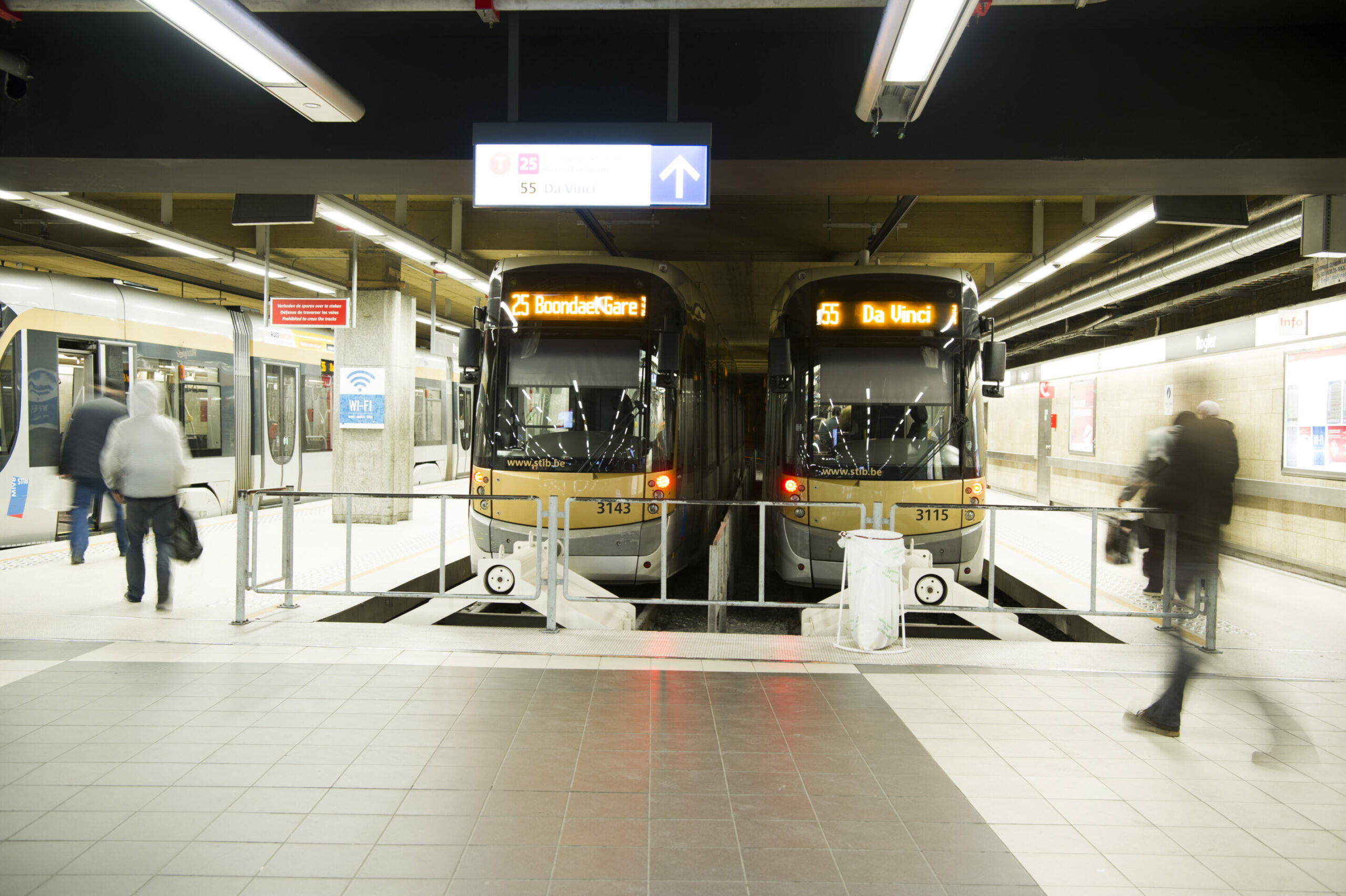
End of Tram 25 at Rogier
However, on the east side all is architectural serenity and stylistic joy. Then and now it comprises two hotels, one Art Nouveau and the other Art Deco. I have visited the public areas of both and whether I can distinguish the two styles is moot. But they are beautiful and very much worth the price of a cup of their coffee.
If you continue east, round the hotels and across Rue Ginestestraat you will come to that haven of peace and greenery Brussels Botanical Gardens. Set out in 1829 and, I read, in English, French and Italian styles it is a refuge for the lunch time sandwich eater or the baby buggy stroller. This peace is for me merely accentuated by the proximity of the Brussels ring to the east and the A20 to the south. You never escape the B-flat hum of the scurrying traffic, but the contrast makes the park even more restful.
And should you wish to walk down from Schaerbeek Port to Rogier do not even think about walking along the pavement of the Botanical Gardens Boulevard. Do yourself a favour and walk through the park. Better for your lungs, your heart, your soul!
